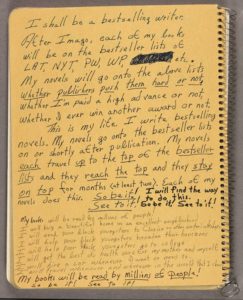Getting clarity on your writing dreams helps you take action to achieve them. From visualising a simple goal, to a story about the future, to getting creative with sticky tape and crayon, here are 8 expert exercises to help you visualise writing success.
1. From affirmations to identity
Affirmations are positive statements that challenge and overcome self-limiting beliefs. The theory is that by repeating them frequently, you begin to believe them, and can start to make positive changes in your life.
Often found at the hyperbolic end of the self-help spectrum, they have a bad rep. Yet there’s evidence they can prime us to change behaviour. As such they can be a first step for aspiring writers.
Take a simple affirmation like: ‘I am a writer.’ Saying that you are a writer affects your self-image and researchers have found that your self-image can influence your behaviour.
Author of Indistractable, Nir Eyal, calls this an identity pact, saying: “By taking on a new identity, you empower yourself to make decisions based on who you believe you are.” This has found to be the case with vegetarians who don’t spend time worrying whether to eat meat or not – their identify makes it easier for them to stick to their diet. So, calling yourself a writer can help you to write.
“By taking on a new identity, you empower yourself to make decisions based on who you believe you are.” Nir Eyal
2. Visualise your goals
Visualising your writing goals can help make them a reality. Having a goal gives us something to aim towards – we need to know our destination to chart a route there.
Start by noting down your writing goal. Put into words what you want to achieve. At this stage, don’t worry about making it SMART – that will come. Instead look for that tingle factor. The feeling of excitement and anticipation when you have a challenge ahead of you, but it’s neither too overwhelming nor a breeze. That’s the goal setting sweet spot.
3. Visualising success
If you imagine a positive outcome, such as what it’s like to achieve a long-held goal, it feels good because it triggers lots of happy-making brain chemicals. Likewise, visualising a bad outcome makes you feel bad.
Neuroscience shows that when you visualise something you stimulate the same parts of the brain as when you actually do it and that causes new neural pathways to emerge. This process of neuroplasticity is central to our development.
Write a list of all the good things that will happen when you achieve your goal. What will you think, do, say? How will you feel? What will the outcome be? One neuroscientist we spoke to suggested writing a list of up to 50 things. It sounds tough, but it will get your brain in gear and flushed with feel good.
4. Draw success
Use visual tools to help your visualisation. Grab a pencil and piece of paper and sketch out your writing dreams and goals. It will embed the message deeper and help you retain it more clearly and for longer.
Visual thinking recorder, trainer and author Cara Holland, says that, “visioning, the act of imagining and drawing the future, can help bring clarity to your ambition. It is this clarity that can help you realise your dreams more quickly.”
>> Read more: How to visualise your writing dreams and goals
5. Collage your dreams
In her bestselling book on creative confidence, The Artist’s Way, Julia Cameron singles out a task that is a favourite for her students: make a collage. Taken from week 7 of her 12-week course, Cameron guides people to get creative with their dreams.
Collect a stack of 10 magazines. Set a timer for 20 minutes to go through the magazines, cutting out all the images that catch your fancy. This part is purely about finding pictures that reflect your life and interests.
>> Read more: The Artist’s Way for Writers
Once you have a pile of cut-out images you’re ready for the next step – assembly. Grab a sheet of paper and something to stick down the images – a stapler, glue or sticky tape. Simply arrange the images in a way that pleases you. Cameron says: “Think of this collage as a form of pictorial autobiography. Include your past, present, future, and your dreams.”
“Think of this collage as a form of pictorial autobiography. Include your past, present, future, and your dreams.” Julia Cameron
6. Learn from business with blueprint for success
Business guru Gary Klein advises companies to create a blueprint for success. In kick-off meetings he gets project teams to imagine a triumph. They begin by reviewing their current plans. Then they time travel six months into the future and imagine the best possible outcome. They envision all the things that went well, what they are celebrating.
The idea behind this is that by seeing a positive outcome you can put in place a plan that makes it more likely for all the great stuff to happen.
>> Read more: How small steps lead to great progress
Gary Klein also advises business leaders to have a project pre-mortem, think of it as a blueprint for failure. Again, time travel into the future this time imaging that everything that could go wrong, has gone wrong.
By predicting disaster you can build contingencies into your writing plans and increase your chance of success.
7. Write a manifesto
When she was a struggling writer, Octavia E Butler wrote a manifesto for success in the inside cover of her notebooks. She went on to become a bestselling, critically-acclaimed and award-winning writer of science fiction.
It was a precise picture of the future for her writing and publishing success. She wrote in detail of what her writing would achieve for her, her family and also how she would pay it forward to others in her situation.
>> Read more: All good things must begin: how visualising success helps writers

Octavia E Butler’s private manifesto
“This is my life. I write bestselling novels. My novels go onto the bestseller lists on or shortly after publication. My novels each travel up to the top of the bestseller lists and they reach the top and they stay on top for months. Each of my novels does this. So be it!”
A manifesto is a declaration of intentions.
While usually published, make like Butler and write yours somewhere private – the important thing is to put your beliefs and aims into words.
“I shall be a bestselling writer.” Octavia E Butler
8. Craft a 10-year plan for a remarkable life
Debbie Millman shared an exercise she uses with her design students at the School of Visual Arts in New York City. Called a 10-year plan for a remarkable life, she was originally taught it by graphic designer Milton Glaser and has honed it over the years.
It starts by imagining 10 years into the future. What does your life look like? She prompts you to visualise in detail from what you doing, where you living, your partner and pets, your house, where it is and how it is furnished. Then you zoom into one day, she says:
“Start from the minute you wake up, brush your teeth, have your coffee or tea, all the way through till when you tuck yourself in at night. What is that day like for you? Dream big! Dream without any fear. Write it all down. You don’t have to share it with anyone except for yourself. Put your whole heart into it, and write like there’s no tomorrow. Write like your life depends on it, because it does.”
Millman’s original 10-year plan came true, and she has exceeded her dreams. As one of the most famous and influential designers in the world, with a top podcast, bestselling books, and portfolio that features designs for Star Wars and Burger King, we’d be wise to heed her advice.
“Dream big! Dream without any fear. Write it all down. … Write like your life depends on it, because it does.” Debbie Millman
Bonus: Revisit your visualisations
An important part of all the visualising exercises is being reminded of your intention.
Octavia E Butler wrote hers in the front cover of her spiral notebook. Cara Holland suggest posting up your drawing on a pinboard or by your desk. Debbie Millman ends her visualisation by encouraging you to read your plan every a year.
You can simply write an affirmation on a post note it and stick it on your computer, or type it as a screen saver. If you want reminding, set a calendar notification or write a letter to the future with FutureMe.
Visualising is no substitute for the hard work of writing, but it can be a good place to start setting your intentions. As Seth Godin wrote in The Practice: “Identity fuels action, and action creates habits, and habits are a part of practice, and a practice is the single best way to get to where you seek to go.”
“Identity fuels action, and action creates habits, and habits are a part of practice, and a practice is the single best way to get to where you seek to go.” Seth Godin




